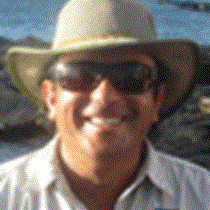Fernandina & Isabela Islands
The whale season has started! The National Geographic Endeavour is sailing the western side of the Galápagos, and here we spot a Bryde’s whale. The planktonic feeder stays calmly on the surface, giving us the chance of identify it properly and observe several blows, as the day breaks in between the active volcanoes that surround us this morning.
Rusty colors are observed on the slopes of La Cumbre Volcano, an imposing 5000-feet summit. This is one the most active volcanoes in the archipelago. Isabela is the largest island, with no introduced animals! Here we walk on lava flows of the Pahoehoe type, where the low tide allows us to find endless marine iguanas swimming offshore to graze on the underwater sea weed, which is the main food for this unique reptile that is found nowhere else in the world. Next to them, red Sally Lightfoot crabs and flightless cormorants are seen resting in this surreal environment. Sea lions are being born this time of the year, and a few newborn pups are found nursing next to their mothers!
The next outing for us is to take the Zodiacs and snorkel in these shallows, where there are Pacific green sea turtles, next to marine iguanas, flightless cormorants, Galápagos penguins and a number of tropical fish—incredible sightings found only in the western islands of the Galápagos.
After a well-deserved lunch, our captain takes the National Geographic Endeavour to the equator line, where our young explorers experience the ceremony of this old sailor’s tradition. A flotilla of Zodiacs is launched from the National Geographic Endeavour, which takes us along the cliffs of Punta Vicente Roca. Sightings of Galápagos fur sea lions, cormorants and a few penguins are the highlight of this joyful day!




